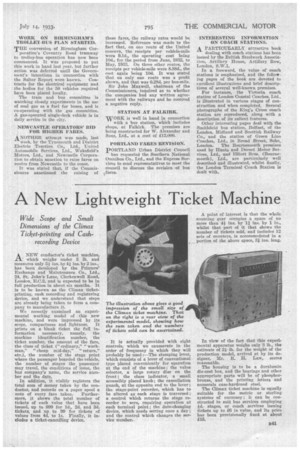A New Lightweight Ticket Machine
Page 55

If you've noticed an error in this article please click here to report it so we can fix it.
Wide Scope and Small Dimensions of the Climax Ticket-printing and Cashrecording Device
ANEW conductor's ticket machine, ' which weighs under 3 lb. and measures only 51 ins. by 41 ins. by 2 ins., has been developed by the Printers' Exchange and Maintenance Co., Ltd., 24, St. John's Lane, Clerkenwell Road, London, E.C.2, and is expected to be in full production in about six months. It is to be known as the Climax ticketprintieg,.cash recording and registering device, and we understand that steps are already being taken to form a company to manufacture it. We recently examined an experimental working model of this new machine, and were impressed by its scope, compactness and lightness. It prints on a blank ticket the full information necessary, namely, the machine identification number, the ticket number, the amount of the fare, the class of ticket (" ordinary," "workman," "cheap mid-day," " return," etc.), the number of the stage point where the passenger boarded the vehicle, the number of stages the passenger may travel, the conditions of issue, the bus company's name, the service number and the date.
In addition, it visibly registers the total sum of money taken by the conductor, and records on a paper spool a
note of every fare taken. Furthermore, it shows the total number of tickets of each value that have been issued, up to 999 for 1d., 2d. and 3d. tickets, and up to 99 for tickets of values from 4d. to 1s. Finally, it includes a ticket-cancelling device. It is actually provided with eight controls, which we enumerate in the order of frequency in which they will probably be used :—The stamping lever, which consists of a lever of conventional type placed conveniently for operation at the end of the machine; the value selector, a large rotary disc on the front; the class indicator, a small accessibly placed knob; the cancellation punch, at the opposite end to the lever; the stage-point recorder, which has to be altered as each stage is traversed; a control which returns the stage recorder to zero, requiring operation at each terminal point; the date-changing device, which needs setting once a day; and the control which changes the service number: A point of interest is that the whole counting gear occupies a space of no than 4i more an ins. by 11 ins. by 1 in., whilst that part of it that shows the number of tickets sold, and includes 12 sets of counters, is accommodated in a portion of the above space, 31 ins. long.
In ra
view of the fact that this experimental apparatus weighs only 3 lb., the estimate of 21 lb. for the weight of the arrived production model, rived at by its designer, Mr. R. EL Law, seems reasonable.
The housing is to be a doraiumin die-cast box, and the bearings and other appropriate parts will be of phosphorbronze, and the printing letters and numerals ease-hardened steel. The Climax ticket machine is equally suitable for the metric or sterling systems of currency; it can be constructed to suit bus services employing id. stages, or coach services issuing
tickets up to £6 value, and its price has been provisionally fixed at about 115.




























































































